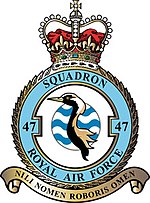No. 47 Squadron RAF
| No. 47 Squadron RAF | |
|---|---|
 |
|
| Active | 1 March 1916–October 1919 1 February 1920–21 March 1946 1 September 1946–31 October 1967 25 February 1968–present |
| Country |
|
| Branch |
|
| Role | Air Transport |
| Garrison/HQ | RAF Brize Norton |
| Motto(s) |
Latin: Nili nomen roboris omen ("The name of the Nile is an omen of our strength") |
| Equipment | Lockheed C-130 Hercules |
| Battle honours | Macedonia 1916–1918*, East Africa 1940–1941*, Egypt and Libya 1942*, Mediterranean 1942–1943*, Burma 1945*, South Atlantic 1982, Gulf 1991, Iraq 2003* *Denotes honours emblazoned on standard |
| Insignia | |
| Squadron badge heraldry | In front of a fountain, a demoiselle crane's head erased. approved by King George VI in November 1938. The unofficial badge had been a sun rising over a pyramid, but tours in Russia and Sudan inspired the use of a crane (found in both countries) which, when navigating, flies high like a bomber. The fountain commemorates the amphibious role when seaplanes were flown off the Nile. |
| Squadron Codes |
EW Allocated Apr 1939–Sep 1939 KU Sep 1939–Sep 1942, Feb 1945–Mar 1946 |
No. 47 Squadron of the Royal Air Force operates the Lockheed C-130 Hercules from RAF Brize Norton, Oxfordshire, England.
No. 47 Squadron Royal Flying Corps was formed at Beverley, East Riding of Yorkshire on 1 March 1916 as a home defence unit, protecting Hull and East Yorkshire against attack by German Zeppelins, being equipped with a mix of aircraft, including Armstrong Whitworth F.K.3s, FK.8s and Royal Aircraft Factory BE.12s. After six months training and flying defensive patrols, it was split up, with two flights joining 33 Squadron, and the remainder being sent to Salonika in Greece, to support forces fighting on the Macedonian Front, arriving on 20 September 1916.
It retained a mixture of aircraft, with two flights being used for reconnaissance and bombing while the third flight operated fighters. When the German battlecruiser Goeben ran aground near outside the Dardanelles after the Battle of Imbros, three 47 Squadron aircraft were sent to attack the stranded ship. Despite continual attacks from these and other aircraft little damage was done to the Goeben owing to the light bombs used. On 1 April 1918, the Royal Flying Corps became part of the Royal Air Force, and the fighter flights (by now equipped with the Royal Aircraft Factory S.E.5A) of both 47 Squadron and No. 17 Squadron were detached to form 150 Squadron. 47 Squadron, now divested of its fighters, and solely equipped with Armstrong Whitworth F.K.8s, was used mainly in the Corps Reconnaissance role, but were used to bomb the retreating Bulgarian forces following the Allied offensive of September 1918.
...
Wikipedia
